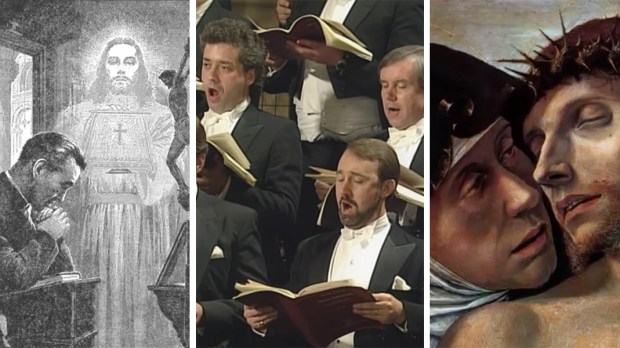Here we are at Holy Saturday at last. We’ve all made it through the toil of Lent and soon we will be in the jubilant season of Easter! To reward ourselves for our well-attended devotions, we’ve put together a playlist of some truly beautiful Catholic music, drawn from as far back as the Renaissance.
The Catholic musical tradition is one steeped in history and culture. For over a thousand years Catholic composers directed the tide of music, orchestrating gorgeous melodies for the glorification of God.
Easter music is not like that of Christmas. There is no great secular drive to produce new (and often drab) songs for the season. This will ultimately work to our benefit, as the pool of polyphony remains undiluted by the mediocrity of pop. Does that sound too harsh? Well then take a dip and see the difference. There is no modern pop song, religious or otherwise, that can compare to the results of a talented composer’s delicate care in arrangement.
We’ve filled this article with individual tracks, so we might give some background to each song, but if you scroll to the bottom, we have a playlist so that you can just let it run in the background for your Easter celebration. We’ve also split the article into two pages, the first is more appropriate for Holy Saturday, while the second is better for Easter.
1 – The Lament of the Mother of God – John Tavener
We’ve included several songs that may be better for Good Friday, but they also work for the solemnity of Holy Saturday. “Lament of the Mother of God” is written in the Orthodox tradition. The composer, Tavener, directs performers to sing “with an ikon-like stillness and great purity.” The result can be heard with the long sustained, ethereal female voices ringing behind the soloist.
2 – Stabat Mater – Pergolesi
This is perhaps the most famous arrangement of the Stabat Mater sequence, a 13th-century hymn to Mary. It is one of Pergolesi’s most celebrated sacred works and was composed just weeks before his death, in 1736. The raw emotion Pergolesi captured in this piece makes it particularly potent for the season. Jean-Jacques Rousseau praised this opening movement, calling it “the most perfect and touching duet to come from the pen of any composer.”
3 – Stabat Mater – Palestrina
Here we have another setting of Stabat Mater. This one is from about 200 years prior to Pergolesi, written by the great Renaissance composer Palestrina. This setting is a motet, sung without accompaniment. This music was designed to allow the performers’ voices to ring through the church, which is one reason for the many pauses between motives. Just imagine how their notes would linger in the high ceilings of a cathedral nave.
4 – Behold the Lamb of God – Handel
The 17th-century composer G.F. Handel is most famous for his oratorio Messiah. “Behold the Lamb of God” is taken from the second part of Messiah, which is most often sung at Christmas, but it is also appropriate for Easter. The text proclaims the testimony of John the Baptist, from John 1:29, which recalls Isaiah 53.
5 – Christ on the Mount of Olives – Beethoven
This is Beethoven’s only oratorio and was his first great success in the United States. The greater work portrays the emotional turmoil of Jesus in the garden of Gethsemane prior to his crucifixion. It concludes when Jesus personally accepts his fate, and places the emphasis on his decision, rather than the later Crucifixion or Resurrection.
6 – Haec Dies – William Byrd
This is an antiphon text associated with Easter and sung during the gradual on Easter Sunday. It was written by the 16th-century English composer William Byrd in a madrigal setting. Madrigals are noted for their freely moving vocal lines, which sometimes repeat each other like a round. The lyrics state: “This is the day the Lord has made, let us rejoice and be glad in it. Alleluia.”
7 – Resurrexit – Berlioz
Berlioz wrote his Messe Solennelle — Catholic Solemn Mass — when he was just 20 years old. This section, the Resurrexit, is written in the jubilation of the Risen Christ. What better way to do that with a bombastic orchestra and a 60-voice celebratory choir?
8 – St. Matthew’s Passion – Bach
This oratorio is widely regarded as a masterpiece of classical sacred music and one of Bach’s finest. Bach wrote most of his works in the early 18th century, but this piece retains many of the polyphonic elements of the Renaissance. The piece follows the Passion of Christ, from the perspective of the Gospel according to Matthew. As this is the longest piece on the list, we saved it for last. It is a perfect background track to leave on during your own Easter celebration.
We’ve put together this playlist on Spotify, in case you want to leave the music running, without clicking for the next track.
[protected-iframe id=”cb4db9163210d38fdf3854ea6a5ce881-95521100-104259047″ info=”https://open.spotify.com/embed/user/216pmxl3cb7osbo6ntnbeqdva/playlist/28Sm1SP5PMc1us6rxTbsdT” width=”300″ height=”380″ frameborder=”0″]

